#anti-tick and flea spot-on for dogs
Text
Prevent parasites with Bark Out Loud: The perfect anti-tick and flea solution
Warmer weather brings our pets a good chance of tick and flea infestations. As good pet parents, it’s important to know how to prevent parasites. This article will show you the threat posed by common springtime bugs among dogs and cats while focusing on the effectiveness of the anti-tick and flea spot-on for dogs by Bark Out Loud.
The threat of springtime parasites
These are minute jumping insects that can cause uneasiness to your animal forcing them to scratch excessively causing bald patches on the skin or even risk of infections. They also transmit tapeworms and put both your lives in danger. These blood-sucking pests attack your pets from outside feeding on their blood, while transmitting diseases like Lyme disease, ehrlichiosis, babesiosis or Rocky Mountain spotted fever. Spread through mosquito bites; heartworm is a fatal parasitic infection affecting the heart & lungs. It must be caught early enough for immediate treatment. These risks are not worth taking when it comes to your pet.
Here are a few signs you should look out for, so you can take immediate action in treating ticks and fleas.
Excessive itching and biting is a common reaction to fleas and ticks causing irritation.
Careful and routine inspection of your pet’s fur, especially around ears, neck, and base of tail for any fleas or ticks can go a long way in preventing them from spreading.
A patch on your dog’s coat with sudden fur loss indicates the infestation by fleas or ticks.
Pale gums or lethargy may mean anemia resulting from severe flea attacks or tick-borne diseases.
Coughing or difficulty breathing can be a symptom of heartworm infection.
If you see such signs consult your vet urgently. Early identification, as well as vet-approved treatment, is important as this would avoid future health problems that could become severe.
Proactive parasite prevention with Barkoutloud's spot-on treatment
Barkoutloud's anti-tick and flea spot-on for dogs is the best flea treatment for dogs & cats. This topical medicine is applied directly to your pet's skin and offers long-term protection.
The active ingredients kill adult fleas and ticks within 24 hours of application, preventing them from laying eggs and multiplying.
The formula continues to kill fleas hatching from eggs for up to 8 weeks on dogs and 12 weeks on cats.
Barkoutloud's spot-on for dogs protects them against heartworm infection for a full month.
You might see many options for anti-tick and flea spot-on or spray, but Barkoutloud offers a formula made you protect your pets without any side effects.
It protects against fleas, ticks, and heartworms in one convenient application.
The applicator allows for mess-free application at home.
Provides continuous protection for weeks, depending on the formula chosen.
Available in separate formulas specifically designed for both dogs and cats.
Understanding the risks presented by springtime pests and using treatment measures like Barkoutloud’s spot-on treatment, will guarantee your pet’s comfort. Especially in the springtime, when pets are an easy target for parasites, an easy-to-use solution will come in handy. To prevent this menace of fleas ticks and heartworms, relying on what you understood from us, will help you keep them away from your pets.
0 notes
Text
Best Dry Dog Shampoos for Stress-Free Bath Time

There are times when a bath for your dog just isn’t in the cards. Maybe your pup isn’t a fan and you’re not ready to spend 20 minutes fending off wet escape attempts. Maybe you just want a little sprucing between grooming appointments. Or maybe you’re on the go, short on time, or otherwise ill-equipped for the undertaking. That’s where dry shampoo for dogs comes in.
A popular solution for pet parents everywhere, dry shampoo for dogs is especially helpful for pups who have anxiety about water or can’t sit still for a bath. It’s also great for dogs who are injured or just out of surgery, since dry shampooing non-sensitive areas can help them freshen up or spot clean without using water.
Best for Heavy-Duty Cleaning

Mighty Mutt No-Rinse Waterless Foam Shampoo
Advertised as “perfect for a quick and easy deep clean,” this foaming shampoo from Mighty Mutt was our go-to choice after Koda the Bernese Mountain Dog went for an impromptu evening roll in mud. Koda was quite proud of her new look, but we certainly weren’t letting her back in the house without giving Might Mutt a go. For this job, we lathered with abandon for a deep clean. The foam was very effective at cleaning and left her with a fresh scent that she may not have enjoyed, but we found much improved.
Mighty Mutt made quick work of a dirty mess, which is great for pups who spend a lot of time outdoors and are inevitably bound to get into something stinky or grimy. Perhaps best of all, Mighty Mutt contains no sulfates, parabens, phthalates, or dyes, and is advertised as anti-itch. Given that Koda has skin sensitivities, this was a good choice for her predicament.

Pros:
Handles a messy coat with no need for a real bath
All-natural ingredients
Pleasant scent
Cons:
Some reviewers note it can be a little sticky, especially if not brushed out
Amazon: Mighty Mutt No-Rinse Waterless Foam Shampoo
Best for Deep Shine

Vet’s Best Waterless Dog Bath
Vet’s Best is another great option for pets with sensitive skin. It’s made with aloe vera, oatmeal, and Neem oil to prevent itching, and it can be used after applying flea and tick preventative, as long as you wait 24 hours. We tested this product on Koda the Bermese Mountain Dog and found that of all the dry shampoos we tested, this one gave her the shiniest, glossiest coat. She looked like she just came out of an actual bath!
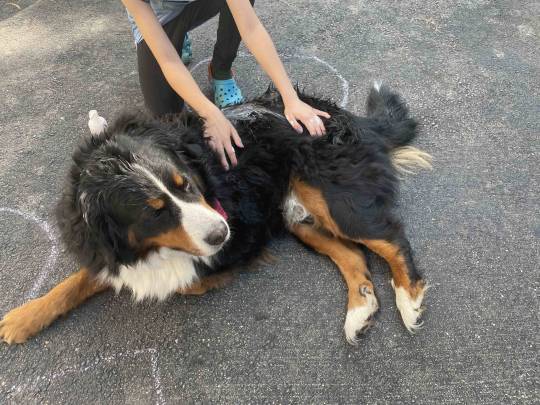
Pros:
All natural ingredients
No residue
Great shine
Cons:
Scent has been reported to be strong and a bit musky
Amazon: Vet’s Best Waterless Dog Bath
Longest-Lasting

Paw Choice Naturals Foaming Mousse Dry Dog Shampoo
This dry shampoo has a pleasant smell and foams into a nice lather on thick coats. Since it’s formulated with sensitive-skin pups in mind, we selected Koda as our prime tester.
Koda started with a clean coat (no mud or obvious dirty spots), but she hadn’t had a bath recently. We applied a moderate amount, and then brushed her out and gave her a quick towel dry. The fragrance was fresh but not overwhelming, and it helped to bring out some of the shine in Koda’s coat.
With its long-lasting properties, this dry dog shampoo could be useful for pups who are injured, just out of surgery, or who detest bath time. We did find, however, that too much lather can leave the fur a little greasy, so a little bit definitely goes a long way. In fact, even with a thick coat of fur and an 85-pound dog, this 7.2-ounce bottle is good for at least five full shampoos.
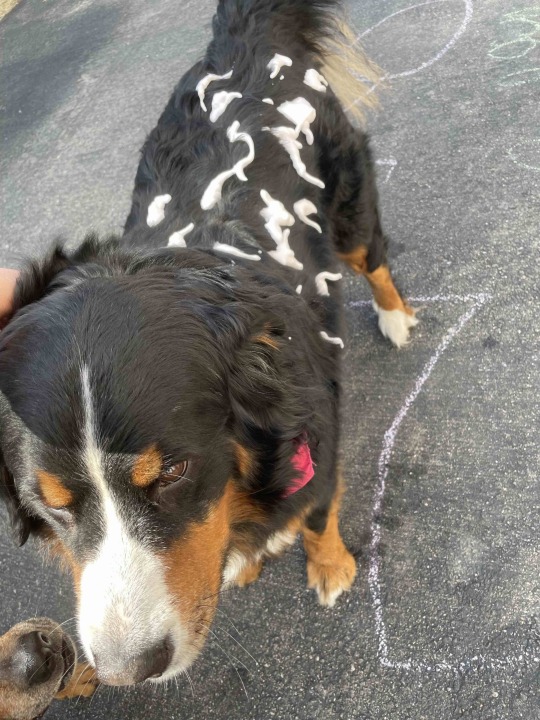
Pros:
Pleasant scent
All-natural ingredients
Cleans thick coats
A little bit goes a long way
Cons:
Leaves a light residue, if you put on a heavy application
Amazon: Paw Choice Naturals Foaming Mousse Dry Dog Shampoo
Best for a Quick Freshen-Up
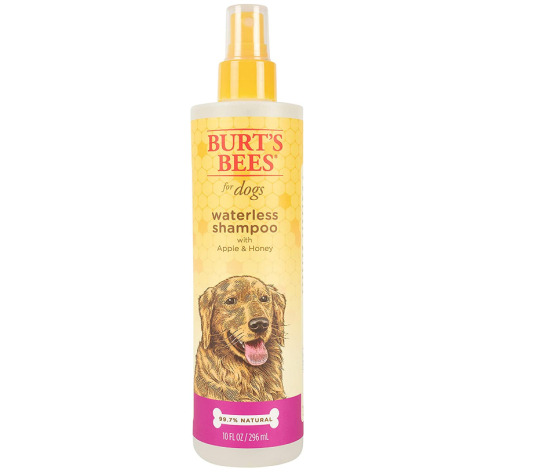
Burt’s Bees Waterless Shampoo for Dogs
This spray-on waterless shampoo is made with 97% natural ingredients, including eucalyptus and honey, that we found left our pets’ coats shiny and nicely scented. Like many dry shampoos for dogs, Burt’s Bees is PH-balanced to help moisturize your dog’s skin, and it’s paraben-free.
We tested this easy spray-on shampoo on Lab-Hound mix Hershey—doing a full-body spray on his dry coat. After spraying the top of Hershey’s coat, we rubbed the spray in to make sure it penetrated his undercoat, then did a light brush. From start to finish, this took only a few minutes, and Hershey came away with a fresh scent (pleasant but not overwhelming) and shiny coat. We’d definitely recommend this product for a quick freshen-up between groomings —but it might not be the best shampoo for really dirty coats.
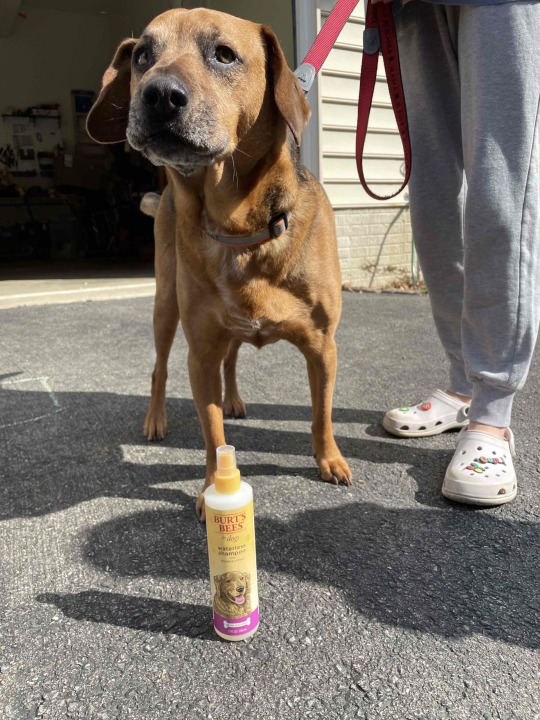
Pros:
Easy and quick to use
Light and pleasant scent
All-natural ingredients
Cons:
Great for a freshen-up, but may not be up to the task for a dirty coat
Amazon: Burt’s Bees Waterless Shampoo for Dogs
Best Scent

Bodhi Dog Premium Lavender Waterless Shampoo
We tested this dry shampoo on Sabine the Doodle because we were interested to see the differences between a spray and a foam shampoo for her poodle coat. The lavender scent of this shampoo is mild but very pleasant—definitely not overwhelming.
We gave Sabine a thorough, full-coat spray and then let her sit for a minute before towel-drying her and giving her a light brush. The brush really brought out the shine in her coat. The spray was easy to use and will probably be a go-to freshen-up in our household moving forward.
Bodhi dry dog shampoo is available in three different scents: lavender, oatmeal, or lemongrass. This waterless shampoo is hypoallergenic and formulated for dogs with sensitive skin. It’s completely free of detergents, alcohol, parabens, and sulfates, which makes it safe for puppies and pregnant dogs.

Pros:
Light and pleasant scent
All-natural ingredients
Made for sensitive skin
Noticeable shine
Cons:
Great for a freshen-up, but may not be up to the task for a dirty coat
Amazon: Bodhi Dog Premium Lavender Waterless Shampoo
Best for Long-Haired Dogs

Begley’s Waterless Pet Shampoo
Begley’s Waterless Pet Shampoo is a no-rinse hypoallergenic shampoo. It’s all-natural and free from harsh additives and comes in a few scents: tea tree, oatmeal mango, lavender, and citrus. It’s meant to be sprayed liberally over your dog’s coat, then wiped with a wet washcloth.
Opting for the tea tree scent, we tested this spray shampoo on a long, thick coat. Unlike when we tested the other foaming shampoos outdoors, we spritzed Koda right in the kitchen with no issues—the scent was pleasant but did not linger on her fur or in the house. It also gave her the most thorough clean of all the spray shampoos we tested, making it a great alternative for dogs who hate taking baths. Some reviewers, however, have stated that they wished the scent was a little stronger to cover their more aromatic pups.

Pros:
Best shine for spray-type shampoo
Hypoallergenic
Light and pleasant scent
Provides most thorough clean of all spray shampoos tested
Cons:
Scent is reported to be mild and not odorizing
Amazon: Begley’s Waterless Pet Shampoo
Best Gentle Shampoo
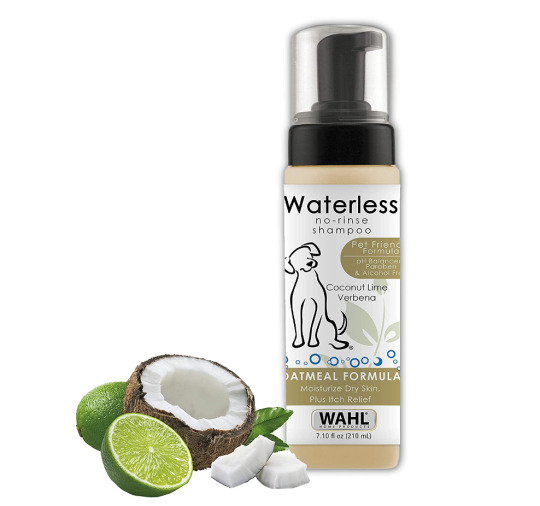
Wahl No Rinse Waterless Dog Shampoo
This vegan and hypoallergenic dry shampoo from Wahl offers gentle cleaning and deodorizing with a strong emphasis on hydration—making it a nice option for dry skin and winter months. It’s one of the gentler options we tested, with a light smell that lasted about twelve hours and no residue to speak of.
This plant derived oatmeal & coconut lime verbena scented waterless shampoo is great for cleansing, conditioning, detangling, & moisturizing animals; the oatmeal formula moisturizes dry itchy skin.
Pros:
Vegan, hypoallergenic, and paraben- and sulfate-free
Gentle and hydrating
Good for repeated use
Light, pleasant scent
Cons:
Great for a freshen-up, but may not be up to the task for a dirty coat
Amazon: Wahl No Rinse Waterless Dog Shampoo
Is Dry Shampoo Safe for Dogs?
Most dry dog shampoos are safe for frequent use, and how often you use them is entirely up to you and your dog’s needs. Some are even designed to help with sensitive or itchy skin and can provide relief from seasonal allergies—so you don’t need to worry about drying out your pup’s coat.
Dry dog shampoo comes in foams, sprays, and powders. What type of product you choose will depend on your specific situation. For example, if you have a pup who doesn’t like to be sprayed, then you may want to opt for a powder shampoo. For mucky hikes and backpacking trips, a heavy-duty foaming mousse could be a more appropriate option.
The most important safety concern? Buying dog-specific products, since dry shampoos for humans aren’t formulated with your pet in mind and shouldn’t be considered for your dog. Some dry dog shampoos also leave behind a light residue and scent, so it’s a good idea to make sure your dog (and you!) can tolerate both before you make waterless baths a regular activity.
2 notes
·
View notes
Text
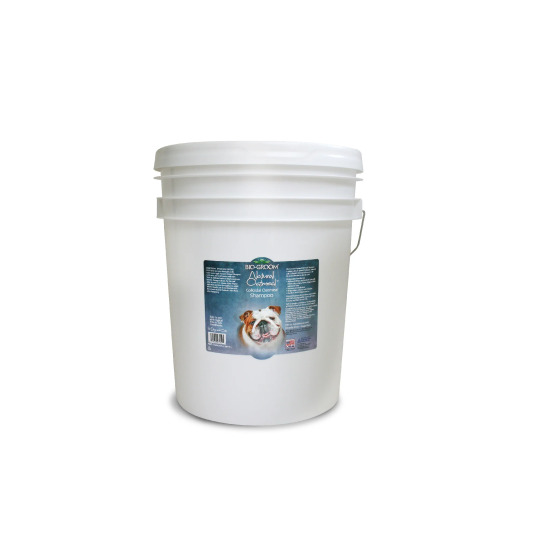
Bio-Groom Natural Oatmeal Soothing Dog Shampoo, 18.9 Litre
Description:
Bio-Groom’s Natural Oatmeal Dog Shampoo™ is recommended by top breeders and professional groomers worldwide. It is made with all-natural Colloidal Oatmeal USP. Colloidal Oatmeal is known to be the most effective on skin & coat. Oatmeal is said to be the best natural remedy for canine skin issues. It helps to relieve allergies, and hot spots, and hydrates skin. Overall oatmeal is a rich natural ingredient to nourish your fur friend’s coat to keep it healthy and shiny.
Specification:
Natural Cleansers are derived from re-growable and 100% biodegradable sources of Coconut Oil
Rinses out quickly, leaving the coat with a fresh clean smell.
Benefits:
Relieves itchiness and protects skin with minor cuts, scrapes, burns, chapped skin and insect bites.
Increases skin hydration.
Helps reduce redness and irritation.
Excellent Anti-Oxidant source.
Natural Cleansers derived from regrowable and 100% biodegradable sources of Corn, Coconut and Palm Kernel Oils.
Safe for puppies, kittens and our environment.
Biodegradable and pH balanced.
Features:
Suitable for dogs
Neutral pH level
Cruelty-Free – Soap Free.
Free Of Parabens and dyes
Safe to use with topical Flea & Tick treatments
All the ingredients used are 100 % Biodegradable
Direction:
Shake well before each use. Wet coat thoroughly with warm water. Apply Natural Oatmeal Shampoo to the coat, and avoid contact with eyes. Work in additional water to obtain maximum benefits. Massage well into the hair and allow to stand for 5 minutes. Rinse. Repeat application and rinse thoroughly. For added anti-itch benefits, use in combination with Bio-Groom’s Natural Oatmeal Créme Rinse after shampooing.
Ingredients:
Purified Water, 2% (RAW) Colloidal Oatmeal USP, Decyl Glucoside, Disodium Cocoamphodiacetate, Sodium Laureth Sulfate, Lauramidopropyl Betaine, Bishydroxyethyl Dihydroxypropyl Stearammonium Chloride, Cocomide DIPA, Vegetable Glycerine, Aloe Vera, Citric Acid, Rainfall Fragrance, Phenoxyethanol.
0 notes
Text
Home Remedies for Managing Minor Skin Infections in Dogs

Introduction
Skin infections in dogs are a common concern among pet owners. These infections can be uncomfortable for your furry friend and may cause itching, redness, and even pain. While it's important to consult a veterinarian for proper diagnosis and treatment, there are several home remedies you can use to manage minor skin infections in dogs. In this article, we will explore these remedies and provide some helpful tips for keeping your dog's skin healthy and infection-free.
To know more about : -
Understanding Skin Infections in Dogs
Before we delve into home remedies, let's briefly discuss the common causes of skin infections in dogs. These infections can be triggered by various factors, including:
Bacterial Infections: Bacteria can thrive in the warm and moist environment of your dog's skin, leading to infections. Common bacterial infections include impetigo and folliculitis.
Fungal Infections: Fungi, such as yeast and ringworm, can cause skin issues in dogs. Fungal infections often lead to redness, itching, and hair loss.
Parasitic Infections: External parasites like fleas and mites can irritate your dog's skin, potentially leading to secondary infections.
Allergies: Allergic reactions to food, pollen, or other environmental factors can manifest as skin problems in dogs. These allergies may cause itching, inflammation, and redness.
Hot Spots: Hot spots are localized areas of inflamed skin that can result from constant licking, scratching, or biting due to an underlying issue.
Home Remedies for Managing Skin Infections in Dogs
Regular Bathing: Keep your dog clean by giving them regular baths with a mild, hypoallergenic dog shampoo. Bathing helps remove dirt, allergens, and potential irritants from their skin.
Apple Cider Vinegar: Diluted apple cider vinegar can help combat fungal and bacterial infections. Mix equal parts of water and apple cider vinegar, then apply it to affected areas using a cotton ball. Allow it to air dry. This remedy can help restore the skin's pH balance.
Aloe Vera Gel: Aloe vera has natural anti-inflammatory and soothing properties. Apply a thin layer of aloe vera gel directly to the affected areas to reduce itching and promote healing.
Coconut Oil: Coconut oil possesses antibacterial and antifungal properties. Gently massage a small amount of coconut oil onto your dog's skin to alleviate dryness and discomfort.
Oatmeal Baths: Oatmeal is known for its soothing properties. Grind plain, uncooked oatmeal into a fine powder and add it to your dog's bathwater. This can help alleviate itching and inflammation.
Honey: Raw honey has antimicrobial properties that can aid in wound healing. Apply a thin layer of honey to the affected area and leave it on for about 20 minutes before rinsing it off.
Epsom Salt Soaks: Epsom salt can help relieve itching and inflammation. Dissolve Epsom salt in warm water and soak a clean cloth in the solution. Gently dab the affected area with the cloth for a few minutes.
Probiotics: Probiotic supplements can help boost your dog's immune system and maintain a healthy gut flora, which can be beneficial in preventing skin infections.
Preventing Skin Infections in Dogs
Prevention is often the best approach to managing skin infections in dogs. Here are some tips to keep your furry companion's skin healthy:
Regular Grooming: Brush your dog's coat regularly to remove dirt, debris, and loose fur. This can prevent matting and reduce the risk of skin issues.
Dietary Considerations: Ensure your dog's diet is well-balanced and suitable for their specific needs. Proper nutrition can support overall skin health.
Flea and Tick Prevention: Use appropriate flea and tick control measures to protect your dog from external parasites that can trigger skin problems.
Environmental Allergens: Identify and minimize exposure to potential allergens in your dog's environment, such as pollen or dust mites.
Avoid Over-Bathing: While regular baths are important, over-bathing can strip your dog's skin of natural oils, making it more susceptible to infections.
Consult a Veterinarian: If you notice any signs of skin infections in your dog, consult your veterinarian promptly. They can provide a proper diagnosis and recommend appropriate treatment.
Conclusion
Skin infections in dogs can be a source of discomfort for your four-legged companion. While home remedies can be helpful in managing minor skin issues, it's crucial to consult a veterinarian for a thorough diagnosis and treatment plan. By following preventive measures and using these home remedies cautiously, you can promote the overall health and well-being of your beloved pet, ensuring their skin stays happy and infection-free.
Read more : -
0 notes
Text
From Flea Allergies to Food Sensitivities: The Best Dog Shampoos for Every Allergy Type
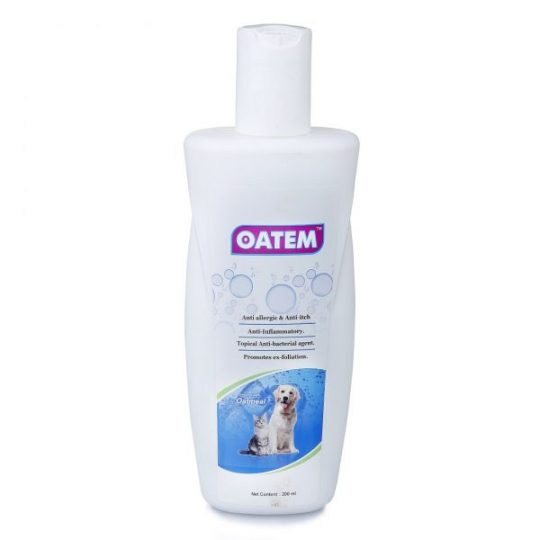
Dogs can be prone to different types of allergies, from flea bites to food sensitivities, and choosing the right shampoo can make all the difference in their comfort and well-being. In this article, we will take a closer look at the best dog shampoos for allergies.
Flea Allergy Dermatitis (FAD): If your dog is suffering from FAD, you need a shampoo that is effective in killing fleas and preventing future infestations. The Adams Plus Flea & Tick Shampoo is an excellent choice, as it contains Pyrethrins, which are natural insecticides that are effective in killing fleas, ticks, and other pests. This shampoo is also pH-balanced to be gentle on your dog's skin.
Food Sensitivities: If your dog has a food allergy, you need a shampoo that is free of the allergens that trigger their reactions. The All Natural Hypoallergenic Shampoo by 4-Legger is an excellent option, as it is made with all-natural ingredients and is free of common allergens, such as soy, wheat, and corn. This shampoo is also free of harsh chemicals, such as sulfates and parabens, making it safe for dogs with sensitive skin.
Environmental Allergies: Dogs that suffer from environmental allergies, such as pollen and dust, may benefit from a shampoo that contains natural anti-inflammatory ingredients, such as colloidal oatmeal. The Oatmeal Shampoo for Dogs by Earthbath is a great choice, as it contains colloidal oatmeal and aloe vera, which work together to soothe and hydrate your dog's skin.
Skin Irritations: If your dog is prone to skin irritations and hot spots, you need a shampoo that is formulated to soothe and protect their skin. The Petway Petcare Allergy Relief Shampoo is a great choice, as it contains colloidal oatmeal, aloe vera, and tea tree oil, which work together to reduce inflammation and itching. The tea tree oil is also a natural antiseptic, which helps to prevent infections caused by scratching.
Atopic Dermatitis: If your dog is suffering from atopic dermatitis, a chronic skin condition that causes itching and redness, you need a shampoo that is formulated to reduce inflammation and relieve itching. The Vet's Best Hypoallergenic Shampoo is a great option, as it contains colloidal oatmeal, neem oil, and Vitamin E, which work together to soothe and protect your dog's skin.
In conclusion, choosing the right shampoo for your dog's specific allergies is important for their comfort and well-being. The shampoos listed above are some of the best options on the market and are specifically designed to treat different types of allergies. Remember to always consult with a veterinarian before making any changes to your dog's grooming routine.
0 notes
Text
Which dog shampoo to buy online to get rid of dog ticks and fleas?
In the hustle of our everyday lives, we do somehow manage to make time for what’s important. We’re sociable beings who understand the importance of hygiene and grooming. However, as pet parents, we are not only responsible for maintaining our own hygiene. The responsibility of looking after our pet’s grooming befalls us too. When you are looking to buy dog shampoo online, as a pet parent you would tend to go for the popular brands. Your google searches must be filled with keywords like ‘earth bath dog shampoo India’ and ‘plush puppy shampoo India’. However, it is important to understand the needs of your dog before choosing the right shampoo for them.
Dog ticks and fleas fester very quickly in mutts, especially in summers when dryness spans its wings across all corners. Fleas and ticks can become a major nuisance and a health risk for your dog if left untreated. Ticks feed on the blood of their hosts and utilize their small but strong teeth to securely attach themselves to the skin and tissue of dogs. Ticks can spread blood-borne infections by infiltrating the bloodstream of their host. Hence, it becomes all the more important to choose the right products for dealing with ticks and fleas in your dogs.

Diagnosing the tick infestation
it's one thing dealing with ticks but identifying the infestation is a different ball game altogether. Tick larvae and nymphs are quite small and can easily be overlooked. The adult tick is roughly 3mm long and most people can see it. Tick bites create bruises on dogs in the area of the bite. It's also not uncommon for the tick to remain attached to the dog’s skin.
Diagnosing the flea infestation
Fleas are just about 1-2 millimeters long, they might be difficult to detect, but there are numerous techniques to check for fleas on your dogs. You can search for irritated and red skin on your mutt’s belly or hind parts. The fleas are generally red and brown in color and can be located while looking at your dog’s coat closely. Fleas often appear as moving entities on your dog’s skin.
Dealing with tick and flea infestations
Post identifying the tick and flea infestations in your mutt, the natural next step is getting rid of them. Giving your mutt a thorough bath with the right shampoo becomes imperative in this scenario. Following are a few shampoos and other products which you can choose from when it comes to dealing with tick and flea infestations -
1. Tropic lean’s Natural Flea & Tick Shampoo- plus Soothing
This Shampoo kills fleas, ticks, and mosquitoes by contact. Our maximum strength formula repels fleas for up to 7 days. This natural essential blend contains some of nature’s most powerful pest-fighting ingredients, maximized with lemongrass and sesame oil, for long-lasting effects. Powerful and effective but safe enough for routine pet baths on dogs and puppies 12 weeks and older.
2. Happy Puppy’s Organic Anti-Tick Massage Oil
Our Tick off Spa massage oil is made with a blend of nourishing cold-pressed oils like coconut, sweet almond, and jojoba and anti-parasitic, anti-bacterial, and anti-inflammatory essential oils like neem, lemongrass, cedar wood, and frankincense oil. It not only helps with getting rid of existing critters but also helps prevent them when you use them as a spot-on treatment.
3. Tropiclean’sAfterBath Flea & Tick Bite Relief Treatment
Spray directly onto affected areas of the pet’s skin and gently massage into the coat. Do not spray in the face or eyes. May be used as often as necessary for immediate relief. It’s a medicated solution formulated to quickly stop itching and irritation from flea and tick bites. This unique medicated blend effectively moisturizes and nourishes the skin for immediate relief from bites, redness, and irritated skin.
We understand that as a pet parent choosing the right dog accessories in Delhi or in India can become a little stressful. But when you’re looking to buy dog shampoo & conditioner online in Delhi or in India our platform offers the best products. There’s a wide range which you can choose from. Till then keep reeling in the glory of your mutts!
0 notes
Text
Commonplace Pet Meds for Your Furry Friends
Introduction
Most people are familiar with the common medicines prescribed for humans, such as antibiotics and pain relievers. But did you know that there are plenty of medications that your furry friends can take, too? In this blog post, we will explore some of the most common pet store near me meds and what they’re used for. From heartworm prevention to anxiety medication, there’s a wide variety of options available to keep your pet healthy and happy. So read on to learn more!
Heartworm and Flea/Tick Medications
As a pet owner, it's important to be aware of the different types of medications available for your furry friend. Heartworm and flea/tick medications are some of the most common pet medications on the market.
Heartworm prevention is an important part of keeping your pet healthy. Heartworm is a serious and potentially fatal condition that is caused by parasitic worms. These worms live in the heart and arteries, and can cause damage to the heart, lungs, and kidneys. Symptoms of heartworm include coughing, fatigue, weight loss, and difficulty breathing.
There are a number of different heartworm prevention medications available, and your veterinarian can help you choose the best option for your pet based on their individual needs.
Flea and tick prevention is also important for keeping your pet healthy and comfortable. Fleas and ticks can cause skin irritation, hair loss, and in some cases, disease. There are a number of different flea and tick prevention products available, including oral medications, spot-on treatments, collars, shampoos, and sprays. Your veterinarian can help you choose the best option for your pet based on their individual needs.
Arthritis Medications
There are a few different types of arthritis medications for pets, and the best one for your pet will depend on the severity of their arthritis. For mild to moderate arthritis, your vet may prescribe an anti-inflammatory medication like ibuprofen or naproxen. These drugs can help reduce pain and swelling in the joints.
For more severe arthritis, your vet may prescribe a disease-modifying antirheumatic drug (DMARD). These drugs work by slowing down the progression of arthritis and can help improve joint function. DMARDs can take several weeks to start working, so they're not ideal for acute pain relief.
corticosteroids are another option for treating arthritis pain. These drugs are powerful anti-inflammatories that can provide quick relief from pain and swelling. However, they can have some serious side effects if used long-term, so they're usually only prescribed for short-term use.
No matter what medication your vet prescribes, it's important to give it as directed and to monitor your pet closely for any side effects. If you have any concerns about your pet's medications, be sure to talk to your vet about them.
Digestive Issues
If your furry friend is having digestive issues, there are a few commonplace pet meds that can help. For example, probiotics can help with diarrhea and vomiting, while antacids can help with heartburn and indigestion. If your pet is constipated, there are laxatives available. And if they're experiencing nausea, there are anti-nausea medications that can help. Talk to your vet about which meds would be best for your pet's specific digestive issues.
Cancer
Cancer is one of the most common health problems in dogs and cats, and it can be devastating to both pets and their families. Early detection and treatment are crucial for the best possible outcome.
There are many different types of cancer that can affect pets, but some of the most common include lymphoma, bone cancer, and mammary cancer. Symptoms will vary depending on the type and stage of cancer, but may include weight loss, lethargy, appetite changes, vomiting, diarrhea, and blood in the stool or vomit.
If you notice any of these symptoms in your pet, it's important to make an appointment with your veterinarian right away. They will be able to perform diagnostic testing to determine if cancer is present and develop a treatment plan accordingly.
While there is no guaranteed cure for cancer, early detection and treatment can greatly improve your pet's chances for a successful outcome. With the help of your veterinarian, you can give your furry friend the best possible chance at a long and happy life.
Pain Management
There are a number of different ways to manage pain in pets, and the best method will vary depending on the individual animal. Common methods of pain management for pets include:
-NSAIDs: Non-steroidal anti-inflammatory drugs (NSAIDs) are a class of medication typically used to reduce inflammation and pain. NSAIDs for pets are available both over-the-counter and by prescription. Some common over-the-counter NSAIDs for pets include ibuprofen and aspirin.
-Opioids: Opioids are a class of medication typically used to relieve severe pain. Opioids for pets are available both over-the-counter and by prescription. Some common over-the-counter opioids for pets include tramadol and codeine.
-CBD: Cannabidiol (CBD) is a compound found in cannabis plants that has been shown to have potential analgesic effects. CBD products for pets are available as oils, capsules, or treats.
The best way to determine which pain management method is right for your pet shop near me is to speak with a veterinarian. They can help you choose the safest and most effective option based on your pet's individual needs.
0 notes
Text
Flea Infestation: How do I know if my dog has fleas?
Let's talk about fleas and ticks on your dog, those nasty and vexing critters that stick to their skin, feast on their blood, and make them exceedingly uncomfortable, if not ill. They are common, but that doesn't make them any less repulsive. Their parasitic behaviours make your four-legged family members miserable; if left unnoticed, they can transmit a variety of unpleasant diseases.
So, where does a dog get these horrible critters? And even if they do, how would you know if your dog has a flea infestation? Should you contact a flea control London service provider? We have got the answers, as well as why it is critical to respond quickly once they are discovered and how to avoid getting them in the first place.
But before all that, let us look at the symptoms of fleas on your dog.
Symptoms of fleas in your dog
Fleas are tiny and hop around a lot on your dog's fur, making them difficult to notice if you don't know what to look for. Here are five red flags that your dog is unknowingly harbouring one or more of these parasites:
· Fleas bite and this makes your pet scratch, bite, or chew their skin. When they do, the protein in their saliva causes an allergic reaction, causing them to scratch even more.
· A flea infestation can lead to hair fall in your pet, especially around the tail and neck. Plus, hair loss may occur when your pet scratches to relieve the irritation caused by bites.
· You see small red pimples on your dog's skin. Fleas are difficult to observe because they jump off their hosts after feeding. However, their bites might irritate your dog's skin, causing discomfort and dermatitis.
· Small black flecks appear on your dog's skin or bedding. Flea filth is a mixture of blood meal and flea faeces.
· Your dog gets a temperature, feels drowsy, or loses his appetite. Fleas can transmit tapeworms and induce anaemia.
How to Examine Your Dog for Fleas
Is it possible to spot fleas on a dog? Make a habit of checking your dog's brush or comb throughout regular grooming sessions. There are numerous ways to inspect your dog for fleas if you feel that there is a problem.
Adult fleas are little and brown, and they are quite easy to spot with the naked eye. Check sparsely-haired areas like your dog's tummy or the inside of her hindquarters by lying on her side.
Flea comb: You may purchase fine-toothed metal flea combs through a local pet supply store or your veterinarian. Apply enough pressure to the comb to make touch with her skin as you run it along her back or underbelly. Adult flea faeces, often known as flea dirt, resemble microscopic black pepper particles. Keep a small bowl of soapy water nearby to drown any adult fleas you may pull up with the comb, preventing them from jumping back onto your dog.
The white towel test: Position your dog on a white paper cloth or towel. Rub or brush coat and examine the towel for any black droppings. Flea dirt has the appearance of microscopic grains of sand and turns crimson when wet.
If you don't notice any fleas, flea filth, or eggs but your dog continues to scratch or seems unhappy, take her to the vet. To screen for flea allergies, your veterinarian might give a skin test. It's also conceivable that your dog has another form of allergy, like atopic, food, or contact allergy, which the veterinarian can diagnose during your visit.
How Can You Get Rid of Fleas?
Fleas can be difficult to remove because they can be found all over the body. Here are a few pointers to help you get through it:
· Brushing your dog's coat can efficiently eradicate fleas.
· Use anti-flea dry shampoos to remove them.
· You can even use specially-designed anti-flea shampoos and oils available on the market.
· Vacuuming and washing your dog's bedding regularly may assist.
· You can also rinse them after they have spent the day playing in muddy regions.
Fleas are not only a nuisance for dogs, but also pet owners. Although home cures might be effective, it is sometimes necessary to seek veterinary guidance to prevent health problems in your dog. Further, you may even contact professional flea control London service to eradicate them from your property.
Fleas are annoying, but they can be avoided. If your dog does have fleas, contact a flea control London service provider to keep your home flea-free and pet dog healthy. However, keep in mind that getting rid of fleas can take up to three months.
Besure Pest Control London recommends getting flea treatment done at least once a year to prevent future infestation and ensure that pets are hale and hearty. Want to know more about fleas control treatment, get in touch with us today!
0 notes
Text
Keeping your pet tick free
Ectoparasite-free pets are clean, healthy and happy pets. Ticks, fleas and mites can cause serious health issues. Tick fever causes anemia and severe weakness and these symptoms can eventually lead to the untimely death of your pets. A life threatening disease called the Lyme disease can even be transmitted to humans by pets. Here is how you can keep your pets tick free.
The areas which need to be checked constantly are inside of the ears, between the toes, near the eyes, around their neck region, underneath their tummy and near the tail and deep in the fur too. Sometimes, ecto-parasites like mites are not visible to the naked eye. So you need to be attentive to see if your pet is either biting its toes or scratching the ears, as these are indicative of irritation caused by the biting of mites and chewing of lice. HOWEVER DO NOT EVER TRY TO PULL THE TICKS AND FLEAS OUT WITH YOUR FINGERS OR TWEEZERS. This will only result in their multiplication.
The common external hiding spots of these ticks, fleas and mites are usually in gardens, lawns, shrubs and tall grasses. They are also found on piles of leaves. Avoid these areas when you take your pet out. However, you must understand that there are also sand mites and dust mites, which are invisible to the naked eye and almost impossible to evade, and these ecto-parasites can travel miles to find your pet and make them their hosts. Make a regular habit to check for ticks and remove them.
It is mandatory that you keep your pets clean by brushing them every day and grooming them regularly as these ecto -parasites find mats and tangles, a favourite place to breed on.
An array of pet products is available pertaining to treating ticks and fleas. These products can be shopped through online pet shops. Apart from the available tick prevention products, ticks on dogs can be treated naturally too. Eucalyptus oil, apple cider vinegar, neem oil etc. can be used to prevent and treat ticks. While treating your pet dog with anti-tick products, always check for the expiry date on products, as they may be in your cupboard for a longer time. Irrespective of the tick treatment you choose, it’s important to do tick prevention regularly to help keep your dog protected long-term, all the seasons and where your dog may roam.
There are a wide range of anti -tick products like oral tablets, Spot Ons, dog shampoos, soaps, powder, available at Glenands Pet Stores to suit every budget, in order to keep your pet tick and flea free and happy this Summer. Drop in at your nearest Glenands Pet Stores for all your pet products.
0 notes
Text
// God what a day/night... Under the cut because it's kinda gross-ish stuff? Some may find it gross anyway. Hopefully the cut has worked since I'm on the app...
// So my son wasn't well last night. I'll never doubt Mother's Intuition as a thing ever again... I randomly woke up at 3am and had a bad feeling. I could hear Mischief coughing. Normal right? I had bad vibes, went in and he was....let's say unwell. Everywhere. Needed a shower at 3am which he was NOT happy with.
// All day he's been lethargic, feeling sorry for himself, not eating or drinking. Just wanted to sleep all the time. Gave him some Calpol, his Nanna heard and (typical Grandma 😆) and rushed over to cheer him up. Luckily got some food and drink down him but not much. He picked up near the end of the day and his temp was fine throughout the day so don't think it's a bug. But...poor boy.
// But while I'm trying to look after him, I noticed my husky has been really struggling with itching. Haven't seen fleas, but he's covered in sores from his scratching/biting/licking. So had to leave my kid with his Nanna while I went to a pet store to find some products to help (partner was at work so was just me and didn't want to drag him out if he's not well).
// Came out with tea tree shampoo, a flea collar and tea tree spray to help with healing and soothing. So spent all night getting Mischief to sleep, bathing Link, treating his wounds I could see....and dealing with my first tick.
// I had a border collie for 13 years as a kid, Link is 6 on Friday and I've never had to deal with ticks. Only had them have fleas ONCE. So I was lost on what to do...the gross ass thing burst as well as I gently tried to pull it out so don't think I got it all so I'm just sitting here panicking.... Makes me wonder if he has a tick allergy and that's why his skin is irritated.
// "uh, Vix, call a vet?" Yeah, I want to, but restrictions are still a thing here and trying to get an appointment with my vets is a nightmare... Link has a tumour in his mouth and they wouldn't see him about it until restrictions ease let alone something like this.
// Dog owners (or cat owners, I guess this is a universal thing for fur-parents). Do you think this is enough for home treatment for him until vets are open properly again?
// 1. I've given him a bath with tea tree shampoo to soothe his skin and help healing. 2. Dried him then used tea tree spray onto the wounds that I can see (he's double coated so it's so difficult to see anything...which is why I can't fully cut out the idea of fleas because it's hard to see through his fur), says on the bottle it soothes skin, aids healing, stops itching and anti-bacterial. 3. Put on a flea/tick collar. 4. Looking into new flea/tick prevention drops since the one I got clearly isn't working... hoping the collar will help until I can get a new order in.
// Any other thing I should do for now while I'm waiting do you think? I'm trying to keep him cool to ease the possibility of heat spots, I've removed the 1 tick I've seen and can't see any other bugs on him and I'll keep a close eye on him. I just hate that he's so itchy like this...
// But yeah, that's why I've not been online today - been looking after my boys... Just hope I've done enough to help them both for now... 😣
#ooc; ~the voice inside my head~#~mobile post~#tw; child mention#tw; dog mention#tw; sickness mention#no his names not Mischief thats just his nickname XD
2 notes
·
View notes
Text
Best anti tick and flea treatment for Dogs & Cats
0 notes
Text
Spa Day (Monstrous Roommates)
(on Ao3)
Virgil was vacuuming. He didn’t particularly care for it, but he had pulled entirely too much fluff out of his computer keyboard the night before; so when he woke up late afternoon alone in the apartment, he’d hauled the vacuum out and started at one end, working towards the other.
He’d never known a werewolf before Patton. He’d heard about them of course; vampires tended to be ridiculous snobs and loved to gossip. It was Remy’s accepting attitude not his need to consume all the tea that set him apart from the rest of the - as Logan had put it- “Blood drinking community” but that didn’t mean what he’d heard was necessarily accurate. The point was Virgil had no idea how Patton managed to shed while in human form. Technically they had a waiver on the lease for Logan’s ‘mobility dog’ but the landlord was cranky as fuck about it, and Patton spent most of his time inside the apartment in skin, not fur. This somehow did not stop the apartment from filling up with mounds of fluffy white and brown fur, especially in the spring.
Logan had said the first couple of springs after they’d moved to Florida were especially terrible, and he had tried to keep up by brushing Patton daily, Patton had a picture of himself sitting sheepishly next to a pile of fur that looked as big as he was, which he found hilarious. Logan had offhand commented that being in an entire house of werewolves was worse, and it made Virgil’s head spin. How did they not simply have carpets of felted fur? It was a mystery.
He’d changed the vacuum bag once and was on his second pass through when he heard the front door unlock and made a face. Patton always said he was going to vacuum, but he hated the noise, and even wearing noise canceling headphones, he tended to rush and miss spots in his desire not to be that close to the machine. Virgil shut it off and stuck his head around the corner into the hallway.
“Sup.” he said and blinked, because Logan was by himself, hanging up Patton’s service dog harness and taking his shoes off.
“Good evening, Virgil.” Logan said pleasantly. Virgil drifted over, kissing Logan on the cheek, before settling back on his heels.
“Not that I’m not thrilled to see you, but didn’t Patton go with you today? You had class in that lecture hall with all the stairs, and the horrible acoustics.”
“He did, but Roman met us as we were leaving campus, and said he was stealing Patton for a spa day. I went to the library alone to study afterwards. Are they not back?”
“Nah, I’ve been alone since I woke up. Been vacuuming.”
“Thank you.” Logan ducked down and gave Virgil a kiss which he smiled into, and maybe kissed back a little. They parted and smiled a bit at each other.
“I don’t know enough about spas to know if it’s been a long time or not.” Logan admitted.
“Me neither. I mean, Roman’s talked me into a pedicure, but that’s not, like, a spa experience.” Virgil had to grin remember the horrified expressions on some of the other customer’s faces as they’d come in, though whether it had been for his gothyness, Roman’s skin tone, or their blatant homosexuality was a question for the ages. White women of a certain type were just too much fun to wind up. It had been kinda nice, even if it had taken some real will power to let someone touch his feet. “Should we text him and find out when they’re coming home?”
“Or we could enjoy the quiet.”
They shared a smile, but Virgil shook his head. “I mean, I’m going to finish vacuuming, so I don’t know how quiet it will be.”
“Well the two loudest members of the household are gone, so I expect very, vacuum and all”
They shared another smile at their boyfreinds’ expense.
Virgil had gotten the vacuum back into storage, and was sitting quietly in the kitchen while Logan made dinner, when the door unlocked and Patton stomped in, looking quite out of sorts. It wasn’t very late, not even seven. It looked as though the ‘spa’ had included a haircut, his curls trimmed back to only a gentle tostle at the top.
“Love, please.” Roman begged following him in. “You look wonderful!”
“Logan tell Roman I’m not speaking to him.” Patton sniffed.
“Over a haircut?” Logan asked, bewildered. Patton turned and glared at Roman.
“Patton, darling” Roman said, failing to his knees and taking Patton’s hands. “Tell me how I can earn your forgiveness sooner. I genuinely thought that you’d enjoy it!”
“What happened?” Virgil asked, pulling an earbud out. “How could a spa day piss Patton off?”
“Spa day.” Patton scoffed. There was polish on his nails, but oddly applied.
“It wasn’t a spa day?” Logan asked.
“I will give him that it was a very high quality dog groomer.”
“Oooh.” Logan winced. “Roman, I’m sorry, Patton isn’t speaking to you.”
“You looked like you were having fun!” Roman protested. “You were very good.”
Patton tensed up, his hair shifting on it’s own before he pulled his hands out of Roman’s and going over to hug Virgil hello. Roman fell face first on the vinyl flooring and didn’t move.
“I take it I shouldn’t compliment the shampoo?” Virgil asked, kissing Patton’s cheek in case that sent him into the dog house with Roman.
“It’s for a glossy coat and anti-flea and tick.” Patton mumbled into his shoulder.
“I wonder how long that’ll last?” Virgil said thoughtfully.
“VIRGE!”
“What, you hate ticks, and I hate taking them off you!” Virgil protested, and pulled Patton into a hug before he could pull away, petting the short clipped hair on the back of his head. Relenting Patton sat in his lap. “You look super cute. Considering they cut it while you were a wolf, it translated well.”
“I know.” he mumbled very quietly. Roman hadn’t moved, as though he’d just given up on the world. “It really was very nice.”
“Are you teasing Roman?” Virgil whispered in his ear.
“A little. He bought me the most enormous apology ice cream.”
Virgil sniggered.
“I’m kind of wondering how long I can draw it out. It was a nice thought, even if it was super tacky.”
“You’re a bad man Patton Hart.” Virgil whispered and kissed him on both cheeks. “Do we get to see the whole effect?”
“Fine, since it’s done anyway.” Patton hopped out of Virgil’s lap, and Logan slapped a lid on the pan as Patton changed forms, since that tended to result in an explosion of shed fur. Nothing happened. Patton stood with his fore-paws on Roman’s back, making him moan piteously, and raised one leg, posing. He was substantially less fluffy than usual, close cropped, with a bit of extra fluff left around his face.
“Tahdah!”
“They groomed all the shed out!” Logan said, astounded. “That never would have occurred to me; after the brushing failed.”
“This is so much cooler. Like, 80% cooler for sure.” Patton said.
“What?!” Roman did his best to push himself off the floor, but was weighed down with a great deal of wolf. “You manipulative jackal!” he cried. “You LIKE it.”
Patton lay down on top of him, laughing, and licked the back of Roman’s head.
“Well, technicaly I didn’t say I didn’t. Just that it was tacky to promise me a spa and bring me to a groomer.”
“Logan, tell Patton I’m not talking to him.”
“Why is it always me?” he demanded.
#Willow is writing#sanders side fic#Monster AU#Werewolf Patton#Vampire Virgil#Mummy Roman#pre-main storyline
53 notes
·
View notes
Text

Bio-Groom Natural Oatmeal Soothing Dog Shampoo
Description:
Bio-Groom’s Natural Oatmeal Dog Shampoo™ is recommended by top breeders and professional groomers worldwide. It is made with all-natural Colloidal Oatmeal USP. Colloidal Oatmeal is known to be the most effective on skin & coat. Oatmeal is said to be the best natural remedy for canine skin issues. It helps to relieve allergies, and hot spots, and hydrates skin. Overall oatmeal is a rich natural ingredient to nourish your fur friend’s coat to keep it healthy and shiny.
Specification:
Natural Cleansers are derived from re-growable and 100% biodegradable sources of Coconut Oil
Rinses out quickly, leaving the coat with a fresh clean smell.
Benefits:
Relieves itchiness and protects skin with minor cuts, scrapes, burns, chapped skin and insect bites.
Increases skin hydration.
Helps reduce redness and irritation.
Excellent Anti-Oxidant source.
Natural Cleansers derived from regrowable and 100% biodegradable sources of Corn, Coconut and Palm Kernel Oils.
Safe for puppies, kittens and our environment.
Biodegradable and pH balanced.
Features:
Suitable for dogs
Neutral pH level
Cruelty-Free – Soap Free.
Free Of Parabens and dyes
Safe to use with topical Flea & Tick treatments
All the ingredients used are 100 % Biodegradable
Direction:
Shake well before each use. Wet coat thoroughly with warm water. Apply Natural Oatmeal Shampoo to the coat, and avoid contact with eyes. Work in additional water to obtain maximum benefits. Massage well into the hair and allow to stand for 5 minutes. Rinse. Repeat application and rinse thoroughly. For added anti-itch benefits, use in combination with Bio-Groom’s Natural Oatmeal Créme Rinse after shampooing.
Ingredients:
Purified Water, 2% (RAW) Colloidal Oatmeal USP, Decyl Glucoside, Disodium Cocoamphodiacetate, Sodium Laureth Sulfate, Lauramidopropyl Betaine, Bishydroxyethyl Dihydroxypropyl Stearammonium Chloride, Cocomide DIPA, Vegetable Glycerine, Aloe Vera, Citric Acid, Rainfall Fragrance, Phenoxyethanol.
0 notes
Text
Causes Of Dog Seizures
They are often called "fits" in England, which is what happens when the brain loses control over the body. They are also known as seizures in America. This article will provide a quick overview of some of the causes of seizures in dogs.
EPILEPSY. Epilepsy is the main cause of seizures in dogs, but not all seizures can be attributed to it. A group of fools who were walking through the woods on a day one discovered the most common form epilepsy. They all saw a wolf in the clearing and reported it to the authorities. The forest rangers were informed about this sighting and the term "idiopathic Epilepsy" was created. Although it is true, the scientific explanation is boringer and makes no sense. The term "idiopathic Epilepsy" can be used to describe seizures in dogs when experts don't know the cause.

TOXINS.Dogs can have seizures from toxins present in their environment. These chemicals can be poisonous to kill rodents and slugs, or flea powders and chemicals meant for dogs to wear as collars. The toxins antifreeze, insecticides, betacbdlondon and paint products can cause seizures as well as kill unwitting animals who ingest them. If an animal suffers a seizure due to environmental poisoning, they can be treated quickly and received prompt intervention.
BRAIN TUMORS. As a possible cause of seizures in dogs, it is easy to determine if there has been an abnormal growth in the brain. The pressure on the brain tissue can lead to seizures or other neurological abnormalities. There are diagnostic tests (MRI and CAT scans), that can help determine if this is the problem. However, tumors and head injuries are only a small percentage of seizures in dogs. Dogs with seizures due to either one of these conditions would not respond to anti-epileptic medications.
TICK INDUCED DISEASES. Lyme Disease and Rocky Mountain Spotted Fever can be caused by tick bites. The chances of getting infected are greatly reduced if the tick is found within 24 hours. Lyme Disease can be treated with antibiotics. Most dogs are able to tolerate antibiotics well.
DISTEMPER. When puppies lose their maternal antibodies around the age of three months, distemper can lead to seizures. This debilitating disease can only be prevented by vaccinations. Dogs who have it will need to fight for their lives.
1 note
·
View note
Text
What is the Most Effective Flea and Tick Treatment for Dogs?

What do vets say about fleas and ticks?
Many reputed and experienced vets say it doesn’t take long for a couple of fleas to duplicate into a major and quick spreading infestation. However fleas may not be as risky as ticks with regards to communicating infections and diseases, your dog may foster a hypersensitive response to flea chomps and an infestation could cause huge tingling, bothering, and even going bald. Fortunately, there are numerous flea and tick control items available that are explicitly intended to safeguard your dogs against these troublesome fleas and ticks.
With regards to fleas and ticks control products, the choices are almost boundless and there are numerous types to consider. Luckily for you, we’ve accomplished the difficult work in scouring the reviews to present to you our top 5 picks for the best flea and tick control products for your dogs.
In this blog, we will talk about the:
Best tick shampoo you can purchase for your dogs
Best flea medicine
The most effective flea and tick treatments for dog
What kills fleas and ticks on dogs instantly?
A good bath with effective anti-tick dog shampoo can always be your instant go-to action when your dogs suffer fleas and ticks. Also, make sure to comb their hair with special flea combs to get rid of any remaining eggs that may bother your pet anytime later.
5 most effective flea and tick treatments for dogs
Best flea medicine
1. Fluid lotion (Spot On) for Ticks and Fleas
While there is a wide range of flea control products for dogs, topical flea treatments are often considered to be the most effective and dependable items available. These medicines normally come in fluid structure and should be applied directly on the dog’s skin once every month for the desired results. Our top pick for the best flea control product for dogs is Frontline Plus in light of the fact that it kills both fleas and ticks and safeguards against re-pervasion for an entire 30 days.
You can Also try disinfecto flea and tick spot on liquid
2. Flea and tick oral pills for your dog
These are the perfect decision for both prevention and treatment of fleas and ticks, it is safe for your dog’s overall health and well-being. You can easily get these oral tablets from your veterinarian.
Best flea medicine for dogs in India!
Vectra 3D is an effective flea and tick prevention tablet for dogs and puppies of age two months and more.
Credelio is an effective, enjoyable, and chewable tablet for flea and tick counteraction for puppies of about two months old and weighing at least 4.4lbs.
Bravecto is a 3 months chewable pill for flea and tick prevention for dogs and puppies of 6 months or more in age, and weighing at least 4.4lbs.
3. Flea and ticks prevention collar
If you’re searching for long-lasting and dependable protection against fleas that you don’t need to re-apply consistently, a flea restraint collar may be the most ideal choice for your dog. However, there are numerous flea collars available in the market, the Qpets flea and tick Collar which is easily available on Amazon is the most trusted and ideal choice of India.
4. Flea spray for dogs
If you’re searching for an all-in-one remedy for grown-up fleas and their eggs, a flea spray might be the most ideal choice. In addition to the fact that you can use flea spray on your dog, you can even use it on his bedding and other household items. Numerous flea sprays offer restricted viability or they are made with perilous synthetics. Our top pick for a protected and viable flea spray for dogs is the Vet’s Best Natural Flea and Tick Spray.
While flea sprays are made with poisonous synthetic compounds, Vet’s Best Natural Flea and Tick Spray contain natural key ingredients like peppermint oil and clove extract.
For best result you can also Try disinfecto’s Clearkill Flea Spray
5. Flea prevention shampoo for your dogs
If you have proactively observed fleas on your dogs, then you might need to give them a pleasant shower with an effective flea shampoo. Flea shampoos are a kind of medicated cleanser that can assist with killing fleas and purging your dog’s skin. Remember that some insect shampoos just kill grown-up fleas while others kill eggs and hatchlings too. So, make sure to choose the flea shampoo according to your requirement.
Our recommendations for the best tick shampoo for your dogs in India are:
Himalaya Erina-EP tick and flea control shampoo
Choostix dog shampoo tick and flea
Wahl 820007 flea and tick shampoo
Captain zack– Excuse me, fleas dog shampoo
Clearkill Cypermethrin 1% Shampoo
0 notes
Text
Some Skin Problems in Dogs
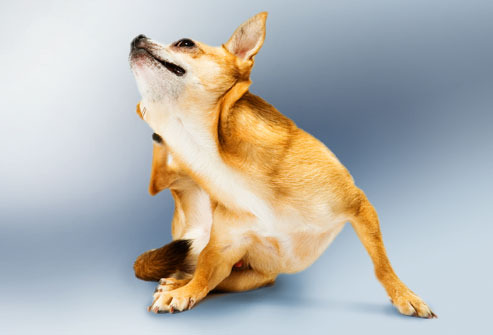
Dog Skin Problems
The sound of a dog constantly scratching or licking can be as irritating as nails on a chalkboard. But don’t blame your pooch for these bad habits -- a skin condition is probably the culprit. Possible causes range from parasites to allergies to underlying illness. WebMD has compiled images of some of the most common canine skin problems.
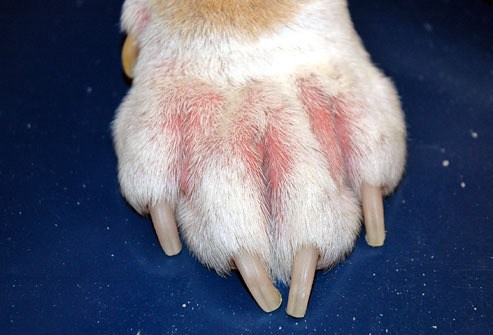
Allergic Dermatitis
Dogs can have allergic reactions to grooming products, food, and environmental irritants, such as pollen or insect bites. A dog with allergies may scratch relentlessly, and a peek at the skin often reveals an ugly rash. Corticosteroids or other, newer medicines can help with itchy rashes. But the most effective treatment is to identify and avoid exposure to the allergens.
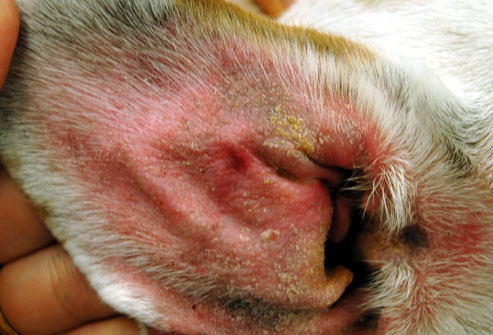
Yeast Infection
If your dog can't seem to stop scratching an ear or licking and chewing their toes, ask your veterinarian to check for a yeast infection. Symptoms include irritated, itchy, or discolored skin. The infection usually strikes the paws or ears, where yeast have a cozy space to grow. Yeast infections are easy to diagnose and often respond well to a topical cream. In some cases, your veterinarian may prescribe oral drugs or medicated baths.

Folliculitis
Superficial bacterial folliculitis is an infection that causes sores, bumps, and scabs on the skin. These skin abnormalities are easier to see in shorthaired dogs. In longhaired dogs, the most obvious symptoms may be a dull coat and shedding with scaly skin underneath. Folliculitis often occurs in conjunction with other skin problems, such as mange, allergies, or injury. Treatment may include oral antibiotics and antibacterial ointments or shampoos.
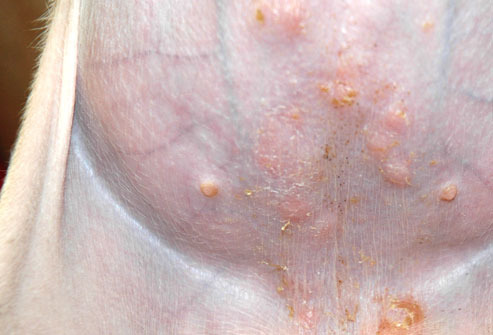
Impetigo
Another type of bacterial infection, impetigo is most common in puppies. It causes pus-filled blisters that may break and crust over. The blisters usually develop on the hairless portion of the abdomen. Impetigo is rarely serious and can be treated with a topical solution. In a small number of cases, the infection may spread or persist.
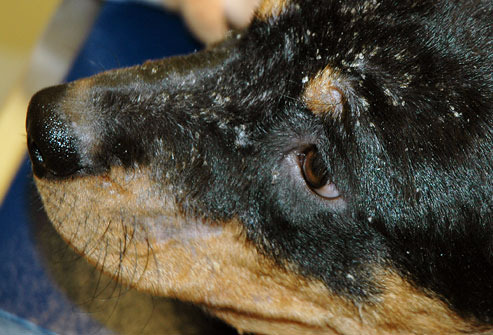
Seborrhea
Seborrhea causes a dog's skin to become greasy and develop scales (dandruff). In some cases, it's a genetic disease that begins when a dog is young and lasts a lifetime. But most dogs with seborrhea develop the scaling as a complication of another medical problem, such as allergies or hormonal abnormalities. In these cases, it is vital to treat the underlying cause so symptoms do not recur. The seborrhea itself typically can be treated with certain medicated shampoos.

Ringworm
Despite its name, ringworm is not caused by a worm, but by a fungus. The term "ring" comes from the circular patches that can form anywhere, but are often found on a dog's head, paws, ears, and forelegs. Inflammation, scaly patches, and hair loss often surround the lesions. Puppies less than a year old are the most susceptible, and the infection can spread quickly between dogs in a kennel or to pet owners at home. Various anti-fungal treatments are available.
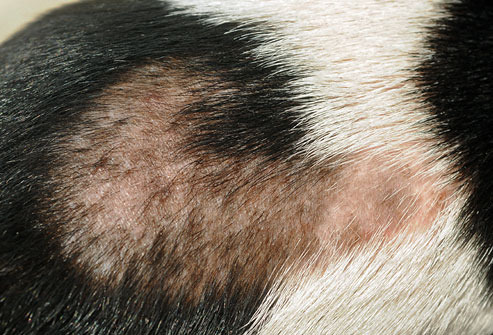
Shedding and Hair Loss (Alopecia)
Anyone who shares their home with dogs knows that they shed. How much shedding is normal depends on breed, time of year, and environment. But sometimes stress, poor nutrition, or illness can cause a dog to lose more hair than usual. If abnormal or excessive shedding persists for more than a week, or you notice patches of missing fur, check with your veterinarian.
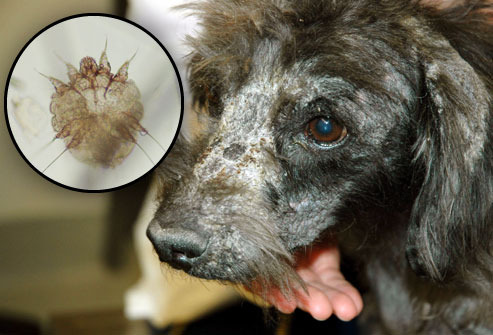
Mange (Mites)
Mange is a skin disorder caused by tiny parasites called mites. Sarcoptic mange, also known as canine scabies, spreads easily among dogs and can also be transmitted to people, but the parasites don't survive on humans. The symptoms are intense itching, red skin, sores, and hair loss. A dog's ears, face and legs are most commonly affected. Demodectic mange can cause bald spots, scabbing, and sores, but it is not contagious between animals or people. Treatment depends on the type of mange.
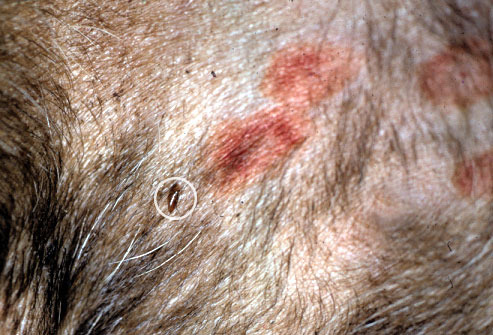
Fleas
Fleas are the bane of any pet owner. You may not see the tiny insects themselves, but flea droppings or eggs are usually visible in a dog's coat. Other symptoms include excessive licking or scratching, scabs, and hot spots. Severe flea infestations can cause blood loss and anemia, and even expose your dog to other parasites, such as tapeworms. Treatment may include a topical and/or oral flea killer and a thorough cleaning of the pet's home and yard.
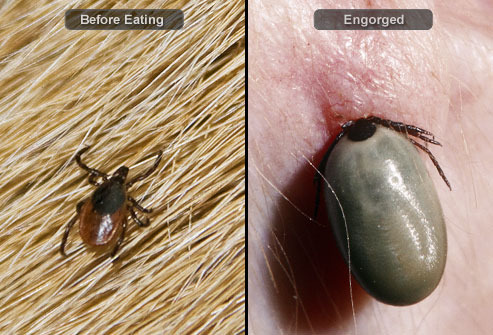
Ticks
Ticks, like fleas, are external parasites that feed on the blood of their hosts. You can spot a tick feeding on your dog with the naked eye. To properly remove a tick, grasp the tick with tweezers close to the dog’s skin, and gently pull it straight out. Twisting or pulling too hard may cause the head to remain lodged in your dog’s skin, which can lead to infection. Place the tick in a jar with some alcohol for a couple of days and dispose of it once it is dead. In addition to causing blood loss and anemia, ticks can transmit Lyme disease and other potentially serious bacterial infections. If you live in an area where ticks are common, talk to your veterinarian about tick control products.

Color or Texture Changes
Changes in a dog's skin color or coat texture can be a warning sign of several common metabolic or hormone problems. They can also result from an infection or other skin disorder. Usually a simple blood test can identify the underlying cause. Be sure to ask your veterinarian about any significant changes to your dog’s coat.

Dry, Flaky Skin
Dry, flaky skin can be a red flag for a number of problems. It's a common symptom of allergies, mange, and other skin diseases. But most often, dry or flaky skin is nothing serious. Make sure you are feeding Fido high quality food. Like people, some dogs simply get dry skin in the winter. If this seems to cause your pet discomfort, consult your veterinarian. Ask whether a fatty acid supplement or a humidifier might help.
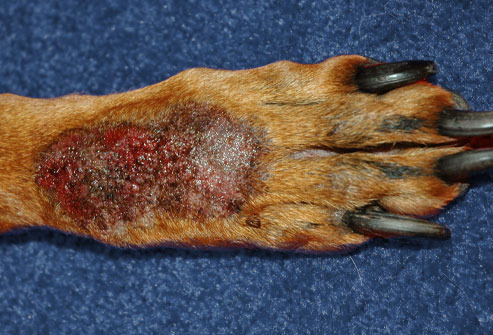
Acral Lick Granuloma
Also called acral lick dermatitis, this is a frustrating skin condition caused by compulsive, relentless licking of a single area -- most often on the front of the lower leg. The area is unable to heal, and the resulting pain and itching can lead the dog to keep licking the same spot. Treatment includes discouraging the dog from licking, either by using a bad-tasting topical solution or an Elizabethan collar. Also ask your dog's vet whether a medication like a topical or corticosteroid might help.
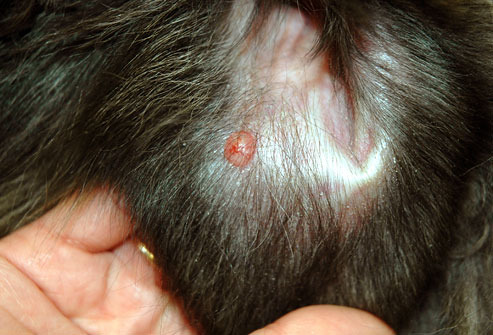
Skin Tumors
If you notice a hard lump on your dog's skin, point it out to your vet as soon as possible. Dogs can develop cancerous tumors in their skin. The only way to confirm a diagnosis of cancer is to biopsy the tumor. If the lump is small enough, your veterinarian may recommend removing it entirely. This can yield a diagnosis and treatment with a single procedure. For tumors that have not spread, this may be the only treatment needed.

Hot Spots
Hot spots, also called acute moist dermatitis, are small areas that appear red, irritated, and inflamed. They are most commonly found on a dog's head, hips, or chest, and often feel hot to the touch. Hot spots can result from a wide range of conditions, including infections, allergies, insect bites, or excessive licking and chewing. Treatment consists of cleansing the hot spot and addressing the underlying condition.
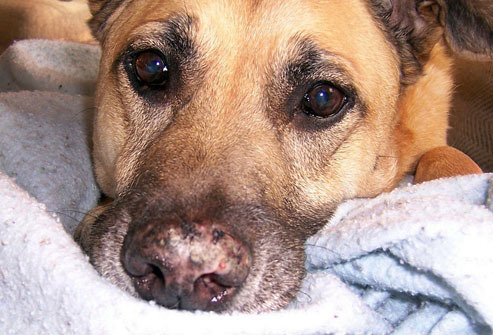
Immune Disorders
In rare cases, skin lesions or infections that won’t heal can indicate an immune disorder in your dog. One of the best known is lupus, a disease that affects dogs and people. Lupus is an autoimmune disorder, meaning the body’s immune system attacks its own cells. Symptoms include skin abnormalities and kidney problems. It can be fatal if untreated.
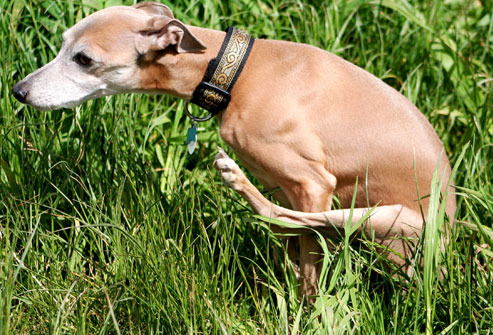
Anal Sac Disease
As if dog poop weren't smelly enough, dogs release a foul-smelling substance when they do their business. The substance comes from small anal sacs, which can become impacted if they don't empty properly. The hallmark of impacted anal sacs is a dog scooting their bottom along the ground. Other symptoms include biting or licking the anal area. A vet can manually express full anal sacs, but in severe cases, the sacs may be surgically removed.
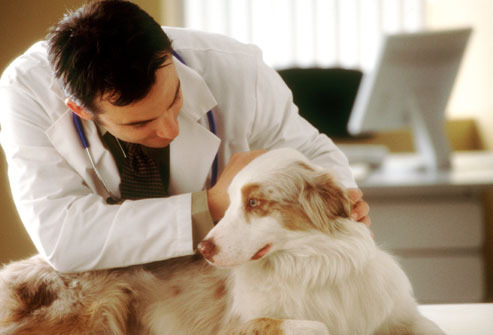
When to See the Vet
Although most skin problems are not emergencies, it is important to get an accurate diagnosis so the condition can be treated. See your veterinarian if your dog is scratching or licking excessively, or if you notice any changes in your pet's coat or skin, including scaling, redness, discoloration, or bald patches. Once the cause is identified, most skin problems respond well to treatment.
1 note
·
View note